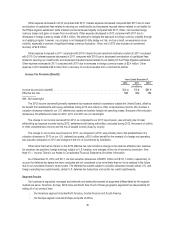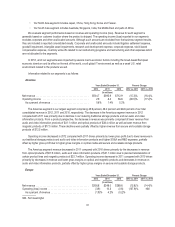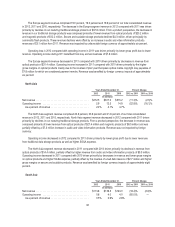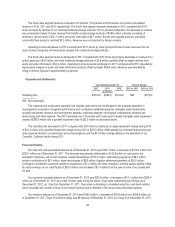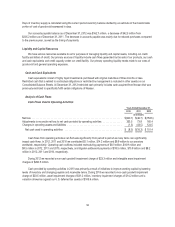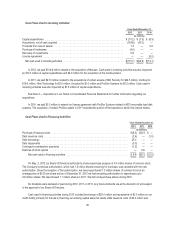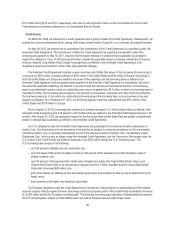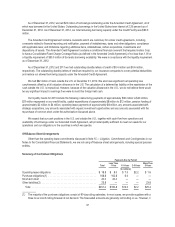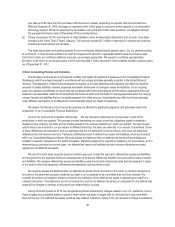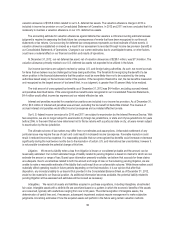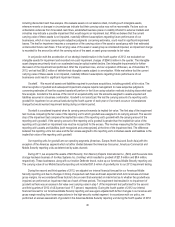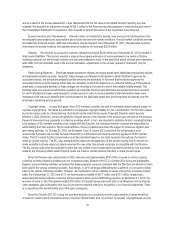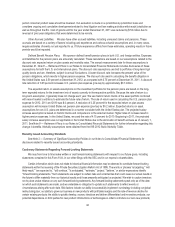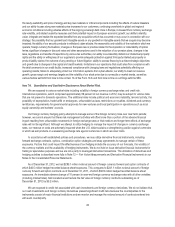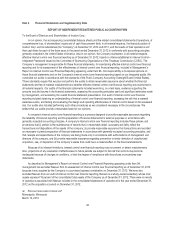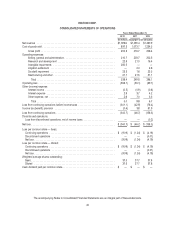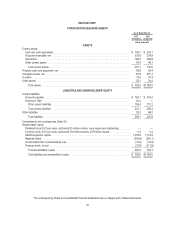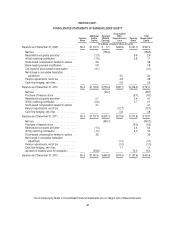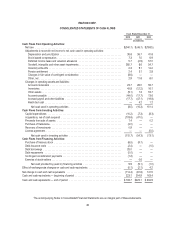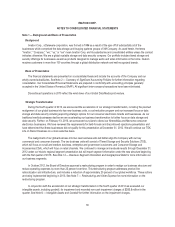Memorex 2012 Annual Report Download - page 43
Download and view the complete annual report
Please find page 43 of the 2012 Memorex annual report below. You can navigate through the pages in the report by either clicking on the pages listed below, or by using the keyword search tool below to find specific information within the annual report.including discounted cash flow analysis. We evaluate assets on our balance sheet, including such intangible assets,
whenever events or changes in circumstances indicate that their carrying value may not be recoverable. Factors such as
unfavorable variances from forecasted cash flows, established business plans or volatility inherent to external markets and
industries may indicate a possible impairment that would require an impairment test. While we believe that the current
carrying value of these assets is not impaired, materially different assumptions regarding future performance of our
businesses, which in many cases require subjective judgments concerning estimates, could result in significant impairment
losses. The test for impairment requires a comparison of the carrying value of the asset or asset group with their estimated
undiscounted future cash flows. If the carrying value of the asset or asset group is considered impaired, an impairment charge
is recorded for the amount by which the carrying value of the asset or asset group exceeds its fair value.
In conjunction with the acceleration of our strategic transformation in the fourth quarter of 2012, we evaluated our
intangible assets for impairment and recorded non-cash impairment charges of $260.5 million in the quarter. The intangible
asset charges are primarily due to an accelerated secular optical market decline. See Intangible Impairments for further
discussion of the impairment test performed. After this impairment loss, and our acquisition of Nexsan, as of December 31,
2012, we had had $80.2 million of definite-lived intangible assets subject to amortization. While we believe that the current
carrying value of these assets is not impaired, materially different assumptions regarding future performance of our
businesses could result in significant impairment losses.
Goodwill. We record all assets and liabilities acquired in purchase acquisitions, including goodwill, at fair value. The
initial recognition of goodwill and subsequent impairment analysis require management to make subjective judgments
concerning estimates of how the acquired assets will perform in the future using valuation methods including discounted cash
flow analysis. Goodwill is the excess of the cost of an acquired entity over the amounts assigned to assets acquired and
liabilities assumed in a business combination. Goodwill is not amortized. We test the carrying amount of a reporting unit’s
goodwill for impairment on an annual basis during the fourth quarter of each year or if an event occurs or circumstances
change that would warrant impairment testing during an interim period.
Goodwill is considered impaired when its carrying amount exceeds its implied fair value. The first step of the impairment
test involves comparing the fair value of the reporting unit to which goodwill was assigned to its carrying amount. The second
step of the impairment test compares the implied fair value of the reporting unit’s goodwill with the carrying amount of the
reporting unit’s goodwill. If the carrying amount of the reporting unit’s goodwill is greater than the implied fair value of the
reporting unit’s goodwill an impairment loss must be recognized for the excess. This involves measuring the fair value of the
reporting unit’s assets and liabilities (both recognized and unrecognized) at the time of the impairment test. The difference
between the reporting unit’s fair value and the fair values assigned to the reporting unit’s individual assets and liabilities is the
implied fair value of the reporting unit’s goodwill.
Our reporting units for goodwill are our operating segments (Americas, Europe, North Asia and South Asia) with the
exception of the Americas segment which is further divided between the Americas-Consumer, Americas-Commercial and
Mobile Security reporting units as determined by sales channel.
During 2011, we acquired the assets of MXI Security, from Memory Experts International Inc., (MXI) and the secure data
storage hardware business of IronKey Systems Inc. (IronKey) which resulted in goodwill of $21.9 million and $9.4 million,
respectively. These businesses, along with our Imation Defender brand, make up our Americas-Mobile Security reporting unit.
The carrying value of our Mobile Security reporting unit included $31.3 million of goodwill prior to our 2012 impairment testing.
During the second and third quarters of 2012, we adjusted our internal financial forecast for our Americas-Mobile
Security reporting unit due to changes in timing of expected cash flows and lower expected short-term revenues and lower
gross margins. As we considered these factors to be an event that warranted an interim test as to whether the goodwill was
impaired, we performed an impairment test as of each of these periods. The impairment test resulted in no impairment of
goodwill as there was an excess in fair value over carrying value in step 1 of the impairment test performed for the second
and third quarters of 2012 of 43.3 percent and 17.7 percent, respectively. During the fourth quarter of 2012 our internal
financial forecast for our Americas-Mobile Security reporting unit was again adjusted with further changes in our revenue and
gross margin resulting from lower expectations in the high-security market segment. In accordance with our policy, we
performed an annual assessment of goodwill in the Americas-Mobile Security reporting unit during the fourth quarter of 2012
40


